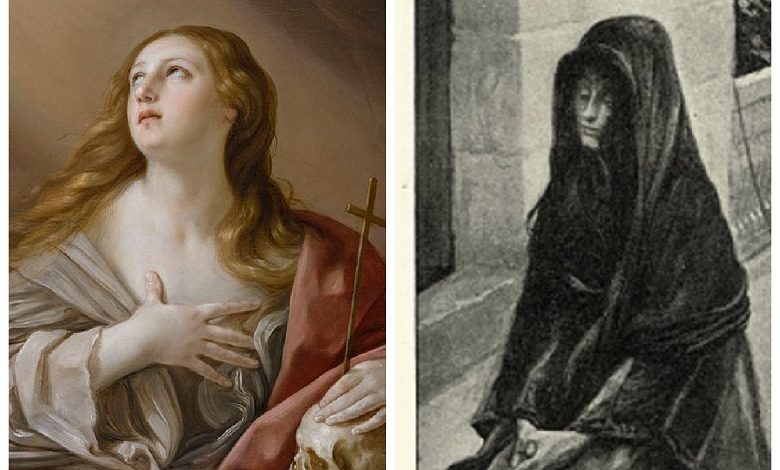The true story of the most famous biblical sinner

Who was Mary Magdalene in real life? Mary Magdalene is a crucial figure in the Bible, specifically in the Gospels of the New Testament.
The role of this woman in the development of Christianity cannot be overestimated, and it also continues to be the subject of the most heated debate among theologians. Why do different branches of Christianity and representatives of other religious structures (and not only) describe Mary Magdalene differently? What do professional representatives of official historical science say about this?
Who was Mary Magdalene?
In the New Testament, Mary Magdalene is described as one of the most devoted followers of the Lord Jesus Christ. It was she who was the first to witness His resurrection from the dead. For centuries, the Western Christian Church has portrayed this woman as a repentant sinner. Recent research by scientists has cast doubt on this interpretation.
Many have accepted the version of the Gnostic Gospels that has recently been discovered. Among them was the Gospel of Mary. According to these manuscripts, Mary is a reflective, wise spiritualist whom Jesus greatly favours.
Who was Mary Magdalene, according to the Bible?
This woman was one of the most ardent followers of Jesus, the most devoted disciple. Most of what we know about her comes primarily from the New Testament scriptures. Experts believe that Mary Magdalene was of Jewish origin, despite all her pagan habits. The name “Magdalene” comes from the name of the city in which she was born, Magdala.
The canonical Gospels of Matthew, Mark, Luke and John describe Mary as a witness to the crucifixion, burial and resurrection of Jesus Christ. References to the Gospel primarily speak only of her physical presence and elementary actions during these events. They do not give us the slightest idea about her personality traits, character or details of her life history. For many centuries, Western Christianity, European art and literature of the Renaissance, and modern media have not portrayed Mary as soon as possible! She was described as a fallen, corrupt woman; she was credited with the role of Jesus’ mistress and even his wife!
She was representatives of the Western branch of Christianity
At the end of the 6th century, Pope Gregory I the Great, who was later canonized and canonized by the Catholic Church, delivered a sermon dedicated to Mary Magdalene. In this sermon, he described her as a repentant sinner. A clergyman highly praised this woman for her devotion and love for Jesus. Pope Gregory suggested that Mary Magdalene might be that sinner from the Gospel of Luke who broke the expensive alabaster vessel and anointed Jesus with myrrh.
She could also be Mary of Bethany, sister of Lazarus and Martha, friends of Jesus. The third assumption concerned the story of the expulsion of seven demons from a woman named Mary. Gregory, I brought these three women together. Regarding the removal of demons, he said that this is similar to the description of the seven deadly sins, among which the sin of lust and greed and pride.
Representatives of the Eastern Orthodox Church rejected this image of Mary. Orthodox doctrine considered it only from the side of the most devoted disciple and follower of Jesus Christ. In medieval Europe, the image of Mary as a repentant sinner was strengthened. This concept flourished in Western theology until recently.
Painters and sculptors usually represented Mary Magdalene in their works dressed as a harlot. Some representatives of Renaissance art depicted her and completely naked.
An alternative history of Mary Magdalene
Canonical in Catholicism, the version of Mary Magdalene, was challenged by the French humanist Jacques Lefebvre d’Etaples in 1518. He very actively objected to the merging of the two Mary: the sister of Lazarus and the unnamed sinner in the Gospel of Luke. D’Etaples insisted on the impossibility of this theory. His position received very little support, but the opposition in religious circles was enormous. It all ended with the fact that in 1521 the views of d’Etaples were officially condemned by French theologians.
In 1969, the Common Roman Calendar put an end to this issue. He determined different dates relating to the appearance of Mary of Bethany and the unknown sinner in the Gospel of Luke.
Who the Gnostic Gospels represent Mary Magdalene
In the late 19th century, scraps of manuscripts were discovered that are known as the Gnostic Gospels. Among these manuscripts were records called the gospel of Mary. The manuscript was written in the 3rd century. In her, Mary Magdalene appears as a completely different person. She has an extraordinary relationship with Jesus, a deep understanding of the very essence of His teaching. She is a knowledgeable and educated woman. The Gospel of Philip describes Mary’s relationship with Jesus as partnership or companionship. There has been interpreted by many to mean that their relationship was very close.
What is known about Mary after Jesus died on the cross? Mary Magdalene is canonized by the Catholic, Orthodox, Anglican and Lutheran churches. This is even though interpretations of her personality vary greatly. According to some historical sources, she accompanied Saint John the Evangelist to Ephesus, near present-day Selcuk, Turkey. The researchers claim that she died there and was buried. Some documents describe her as an evangelist preaching in the south of France. Medieval legend even tells that she was the wife of John.
Modern views on the figure of Mary Magdalene
The image of Mary Magdalene continues to be incredibly popular in all forms of art. This woman is a proper object of admiration for representatives of the Christian religion and secular people.
Many film adaptations have been made about Mary. Almost all of them are mega-popular. One of the most famous is the film based on the novel by Nikos Kazantzakis, “The Last Temptation of Christ”, directed by the great Martin Scorsese. The image of Mary Magdalene is essential in the rock opera “Jesus Christ Superstar” by Andrew Lloyd Webber and Tim Rice. In 2004, Mel Gibson directed a compelling film called The Passion of the Christ, starring the gorgeous Monica Bellucci as Mary. This film uses the image of Mary as a repentant sinner who followed Christ. In 2003, Dan Brown’s novel The Da Vinci Code was released. The work gained enormous popularity; a film of the same name was filmed based on the book. There Mary Magdalene appears in the image described in the Gnostic Gospels.
Mary’s story was again in the spotlight during the live broadcast of NBC’s Jesus Christ Superstar on Easter Sunday 2018, starring Sarah Bareilles. Around the same time, the biblical drama Mary Magdalene, starring Rooney Mara, became popular in theatres. In the story, a young woman tries to avoid a marriage of convenience. Joaquin Phoenix brilliantly played the role of Jesus in this film.




